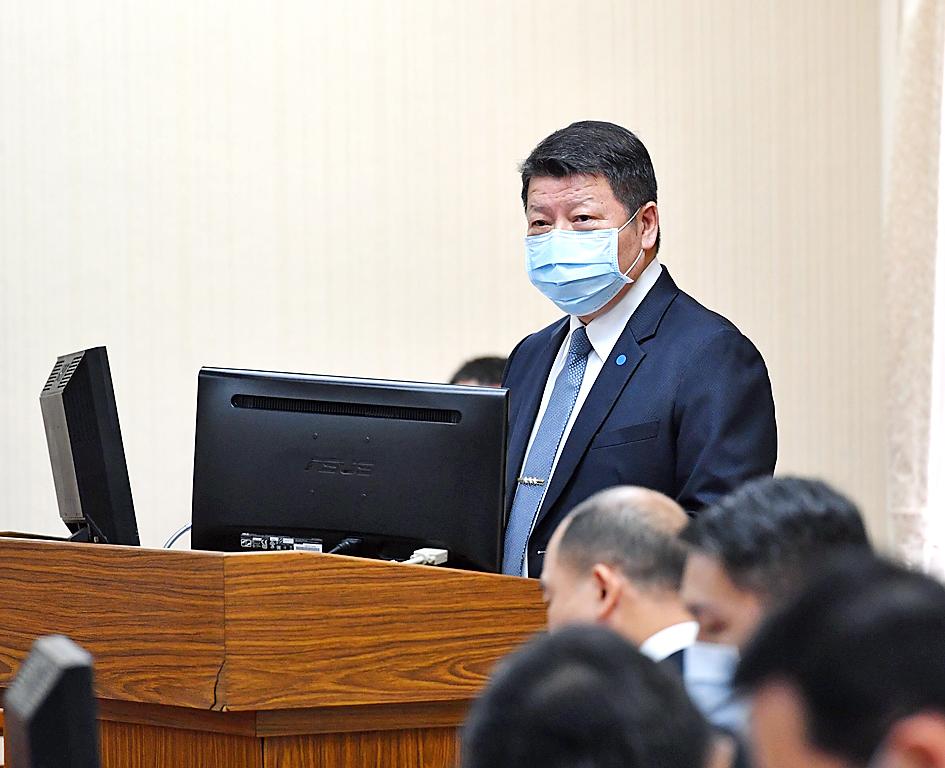The Ministry of National Defense (MND) yesterday confirmed media reports that it plans to purchase coastal defense cruise missile (CDCM) systems from the US, saying that they could be delivered by 2023, should Washington agree to sell.
At a meeting of the Legislative Yuan’s Foreign Affairs and National Defense Committee, Democratic Progressive Party (DPP) Legislator Tsai Shih-ying (蔡適應) asked the ministry to respond to rumors about plans to purchase CDCMs, a truck-mounted system of Harpoon anti-ship missiles made by Boeing Defense, Space & Security for mobile coastal defense.
Deputy Minister of National Defense Chang Che-ping (張哲平) said that the ministry and the Chungshan Institute of Science and Technology (CSIST) had reviewed national missile production capabilities through 2025.

Photo: CNA
The review found that the nation is incapable of fielding sufficient missiles to annihilate 50 percent of enemy forces on Taiwanese shores in the event of a Chinese invasion, Chang said.
Taiwan has operated indigenous Hsiung Feng II subsonic anti-ship missile systems since 1988 and its supersonic variant, the Hsiung Feng III, since 2007.
After Tsai asked about annual production of the locally made missile systems, Chang said that he would have to verify the numbers.
Harpoon missiles are similar to the Taiwanese weapons, although the Hsiung Feng II has greater range and a faster cruising speed, CSIST president Art Chang (張忠誠) said, adding that the truck-borne Harpoons allow for comparatively greater mobility than the Hsiung Feng II, which needs to be towed.
Meanwhile, Chang Che-ping said that the ministry was not aware of Minister of Foreign Affairs Joseph Wu’s (吳釗燮) comments about potential Chinese People’s Liberation Army actions against Taiwan.
In a video interview with Fox News anchor Martha MacCallum on Tuesday, Wu said that Taiwan and the global community are watching Beijing’s actions in Hong Kong closely.
Asked if it were possible that China might deploy its military against Taiwan or in Hong Kong, Wu said that the Chinese government is trying to fully take over the administration in Hong Kong.
There is “also concern that China might take some military action against Taiwan,” he said. “That’s what I said all along: When the Chinese government is facing crisis domestically, the best way for it is to find a scapegoat outside, and Taiwan can be a very easy scapegoat for China.”
Some reports mistakenly reported Wu as saying that China’s next step would be to take Taiwan by force, Ministry of Foreign Affairs spokeswoman Joanne Ou (歐江安) said yesterday.
Chang Che-ping told the committee that the military had contingency plans in place and was closely monitoring the Taiwan Strait, but it would not “make a blind move” based on a single comment.
Military readiness levels remain normal and adjustments would depend on developments in Hong Kong, which the military is closely monitoring, he said.
The MND has contingency plans in place for any Chinese invasion scenario, he said.

MISINFORMATION: The generated content tends to adopt China’s official stance, such as ‘Taiwan is currently governed by the Chinese central government,’ the NSB said Five China-developed artificial intelligence (AI) language models exhibit cybersecurity risks and content biases, an inspection conducted by the National Security Bureau (NSB) showed. The five AI tools are: DeepSeek, Doubao (豆包), Yiyan (文心一言), Tongyi (通義千問) and Yuanbao (騰訊元寶), the bureau said, advising people to remain vigilant to protect personal data privacy and corporate business secrets. The NSB said it, in accordance with the National Intelligence Services Act (國家情報工作法), has reviewed international cybersecurity reports and intelligence, and coordinated with the Ministry of Justice Investigation Bureau and the National Police Agency’s Criminal Investigation Bureau to conduct an inspection of China-made AI language

BOOST IN CONFIDENCE: The sale sends a clear message of support for Taiwan and dispels rumors that US President Donald Trump ‘sold out’ the nation, an expert said The US government on Thursday announced a possible sale to Taiwan of fighter jet parts, which was estimated to cost about US$330 million, in a move that an expert said “sends a clear message of support for Taiwan” amid fears that Washington might be wavering in its attitude toward Taipei. It was the first announcement of an arms sale to Taiwan since US President Donald Trump returned to the White House earlier this year. The proposed package includes non-standard components, spare and repair parts, consumables and accessories, as well repair and return support for the F-16, C-130 and Indigenous Defense Fighter aircraft,

CHECKING BOUNDARIES: China wants to disrupt solidarity among democracies and test their red lines, but it is instead pushing nations to become more united, an expert said The US Department of State on Friday expressed deep concern over a Chinese public security agency’s investigation into Legislator Puma Shen (沈伯洋) for “secession.” “China’s actions threaten free speech and erode norms that have underpinned the cross-strait ‘status quo’ for decades,” a US Department of State spokesperson said. The Chongqing Municipal Public Security Bureau late last month listed Shen as “wanted” and launched an investigation into alleged “secession-related” criminal activities, including his founding of the Kuma Academy, a civil defense organization that prepares people for an invasion by China. The spokesperson said that the US was “deeply concerned” about the bureau investigating Shen

‘TROUBLEMAKER’: Most countries believe that it is China — rather than Taiwan — that is undermining regional peace and stability with its coercive tactics, the president said China should restrain itself and refrain from being a troublemaker that sabotages peace and stability in the Indo-Pacific region, President William Lai (賴清德) said yesterday. Lai made the remarks after China Coast Guard vessels sailed into disputed waters off the Senkaku Islands — known as the Diaoyutai Islands (釣魚台) in Taiwan — following a remark Japanese Prime Minister Sanae Takaichi made regarding Taiwan. Takaichi during a parliamentary session on Nov. 7 said that a “Taiwan contingency” involving a Chinese naval blockade could qualify as a “survival-threatening situation” for Japan, and trigger Tokyo’s deployment of its military for defense. Asked about the escalating tensions